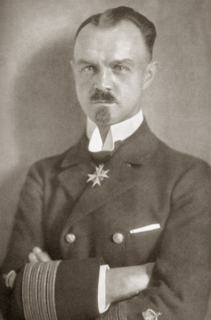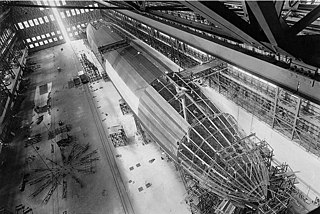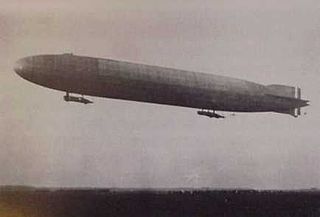This article possibly contains original research .(May 2011) |
Luftschiffertruppe, a German word meaning "airshipmen's troop", was the designation[ citation needed ] of the German airship units.
This article possibly contains original research .(May 2011) |
Luftschiffertruppe, a German word meaning "airshipmen's troop", was the designation[ citation needed ] of the German airship units.
The origin of the Luftschiffertruppe was the Versuchsabteilung der Luftschiffertruppe ("experimental airship unit") first raised in 1884 as part of the army which was tasked with the evaluation of tethered observation balloons, first using ball-type balloons but in 1896 introducing elongated Parseval-Sigsfeld kite balloons.
On August 1, 1914, the distinction was made between
In October 1916, the Feldluftschiffer were subordinated to the "Commanding General of the Air Force".
The origin of the Luftschifftruppe ("airship troop") was a special Versuchskompanie für Motorluftschiffahrt ("experimental unit for powered airship navigation") organized in 1906 as part of the Luftschiffertruppe. After tests of the different available airship types, the semi-rigid Groß airship and the Parseval blimp were abandoned while the rigid airships of Zeppelin and Schütte-Lanz design were selected for service.
While the use of airships for military purposes had been pioneered by the German army, in 1913 the navy raised their own airship troops. After operating in varying command structures for the first years of the war, in late 1916 the navy took over airship operations on the western front while the army became responsible for the east and the Balkans.
Until 1918, the army launched 50 airships, the navy 73. 17 army and 23 navy ships were lost to the enemy, 9 army and 30 navy ships were lost to other causes.
The Luftschiffer became the backbone of German aerial warfare in the first years of the War, conducting reconnaissance flights as well as the first bombings of cities, including Paris and London.
Upon the outbreak of World War I, the Luftschifftruppe numbered around 20–25 zeppelins in service. The Luftschifftruppe began aerial surveillance early on in Belgium and France, but often came under fire by anti-aircraft guns. Because of their slow speed, they were very vulnerable. After three Zeppelins were shot down in the first month alone, the Luftschiffer were switched to naval surveillance, observing British ship movements, in which capacity they played a decisive role in the Battle of Jutland. Tests were done of dropping bombs from Zeppelins in order to increase their potential. Zeppelins had a typical carrying capacity of almost 9 metric tons, making them useful enough for this operation. Following the Christmas truce, Kaiser Wilhelm II approved of the Luftschifftruppe's bombing of England. On January 19, 1915, the first bombs fell over Britain, when two Zeppelins dropped 50 kg explosives on villages outside Great Yarmouth. Five people died in the first raid; 18 more raids that year would end in almost 900 casualties. Following the terror, the British government began taking measures to stop the bombings. Anti-aircraft guns were set up all over south-eastern England, as well as spotlights for night time.
The bombings in 1916 were more intense than in 1915. After an accidental bomb-dropping on London, the Kaiser approved of raids directly against the city's urban center. Twenty-three raids on London resulted in around 1,800 casualties. Despite safety precautions, civilians were still unprepared for the raids and zeppelins were still able to avoid defenses. By 1917 and 1918 the threat the Luftschifftruppe posed to London was diminished. Large-scale introduction of fighter planes caused nearly half of the planned bombings to end in failure. Only eleven successful raids occurred in the last year of the war. Nearly 80 zeppelins had been built for the Luftschifftruppe during the war; around 60 of them were shot down, including Peter Strasser's own zeppelin, with himself on board.
The Luftschiffer's career and service to Germany came to an end when, following World War I, the Luftschifftruppe was dismantled and barred from existence by the Treaty of Versailles, which prohibited Germany from owning an air force under articles 198 and 202.

A Zeppelin is a type of rigid airship named after the German inventor Count Ferdinand von Zeppelin who pioneered rigid airship development at the beginning of the 20th century. Zeppelin's notions were first formulated in 1874 and developed in detail in 1893. They were patented in Germany in 1895 and in the United States in 1899. After the outstanding success of the Zeppelin design, the word zeppelin came to be commonly used to refer to all rigid airships. Zeppelins were first flown commercially in 1910 by Deutsche Luftschiffahrts-AG (DELAG), the world's first airline in revenue service. By mid-1914, DELAG had carried over 10,000 fare-paying passengers on over 1,500 flights. During World War I, the German military made extensive use of Zeppelins as bombers and as scouts, resulting in over 500 deaths in bombing raids in Britain.

An airship or dirigible balloon is a type of aerostat or lighter-than-air aircraft that can navigate through the air under its own power. Aerostats gain their lift from a lifting gas that is less dense than the surrounding air.

The Royal Naval Air Service (RNAS) was the air arm of the Royal Navy, under the direction of the Admiralty's Air Department, and existed formally from 1 July 1914 to 1 April 1918, when it was merged with the British Army's Royal Flying Corps to form the Royal Air Force, the world's first independent air force.

This is a list of aviation-related events from 1915:
This is a list of aviation-related events from 1916:

Peter Strasser was chief commander of German Imperial Navy Zeppelins during World War I, the main force operating bombing campaigns from 1915 to 1917. He was killed when flying the German Empire's last airship raid over the United Kingdom.

The Deutsche Luftstreitkräfte —known before October 1916 as Die Fliegertruppen des deutschen Kaiserreiches abbreviated to Die Fliegertruppe—was the air arm of the Imperial German Army. In English-language sources it is usually referred to as the Imperial German Air Service, although that is not a literal translation of either name. German naval aviators of the Marine-Fliegerabteilung were an integral part of the Imperial German Navy. Both military branches operated aeroplanes, observation balloons and airships.

A rigid airship is a type of airship in which the envelope is supported by an internal framework rather than by being kept in shape by the pressure of the lifting gas within the envelope, as in blimps and semi-rigid airships. Rigid airships are often commonly called Zeppelins, though this technically refers only to airships built by the Luftschiffbau Zeppelin company.
The best known German strategic bombing campaign during the First World War was the campaign against Britain, although strategic bombing raids were carried out or attempted on other fronts. The main campaign against Britain started in January 1915 using airships. From then until the end of the war the Marine-Fliegerabteilung and Die Fliegertruppen des deutschen Kaiserreiches mounted over 50 bombing raids on the United Kingdom. These were generally referred to as Zeppelin raids, although Zeppelin and Schütte-Lanz airships were used, the Zeppelin company was much better known and was responsible for producing the majority of the airships. Weather and night flying made airship navigation and accurate bombing difficult. Bombs were often dropped miles off target and hitting military installations was impossible. The civilian casualties made the Zeppelins an object of hatred and they were dubbed "baby-killers". With the development of defensive measures the airship raids became much more risky and in 1917 the airships were largely replaced by aeroplanes.

The spy gondola, spy basket, observation car or sub-cloud car was a manned vessel that an airship hiding in cloud cover could lower several hundred metres to a point below the clouds in order to inconspicuously observe the ground and help navigate the airship. It was a byproduct of Peilgondel development. They were used almost exclusively by the Germans in the First World War on their military airships.
Gross-Basenach or Groß-Basenach is the designation for a series of five so-called M-class German military semi-rigid airships constructed by balloonist Nikolaus Basenach and Major Hans Georg Friedrich Groß (1860–1924) of the Royal Prussian Airship Battalion Nr 2 between 1907 and 1914.
The Schütte-Lanz SL 11 was a German military dirigible built in 1916 by Luftschiffbau Schütte-Lanz. It was the first German airship to be shot down while bombing England.

The LZ 61 was a World War I German Navy airship, allocated the tactical numbering 'L 21'. It carried out a total of ten raids on England, and 17 reconnaissance missions.

Zeppelin LZ 54, given the military tactical designation L 19, was a Zeppelin of the Imperial German Navy. While returning from her first bombing raid on the United Kingdom in early 1916, she came down in the North Sea. Her crew survived the crash, but drowned after the crew of a British fishing vessel refused to rescue them; at the time this was a widely reported and notorious incident.

Strategic bombing during World War I was principally carried out by the United Kingdom and France for the Entente Powers and Germany for the Central Powers. All the belligerents of World War I eventually engaged in strategic bombing, and, with the exception only of Rome and Lisbon, the capital cities of all the major European belligerents were targeted. A multi-national air force to strike at Germany was planned but never materialized. The aerial bombing of cities, intended to destroy the enemy's morale, was introduced by the Germans in the opening days of the war.

The Zeppelin R Class was a type of rigid airship developed by Zeppelin Luftschiffbau in 1916 for use by the Imperial German Navy and the German Army for bombing and naval patrol work. Introduced in July 1916 at a time when British air defences were becoming increasingly capable, several were lost in the first months of operation, leading the Germans to reconsider their technical requirements and eventually to develop airships capable of bombing from a greater height. Most surviving examples were modified to meet these requirements, by reducing weight at the expense of performance. A total of 17 were built.

The Imperial German Navy Zeppelin LZ 48 was a P-class World War I zeppelin.